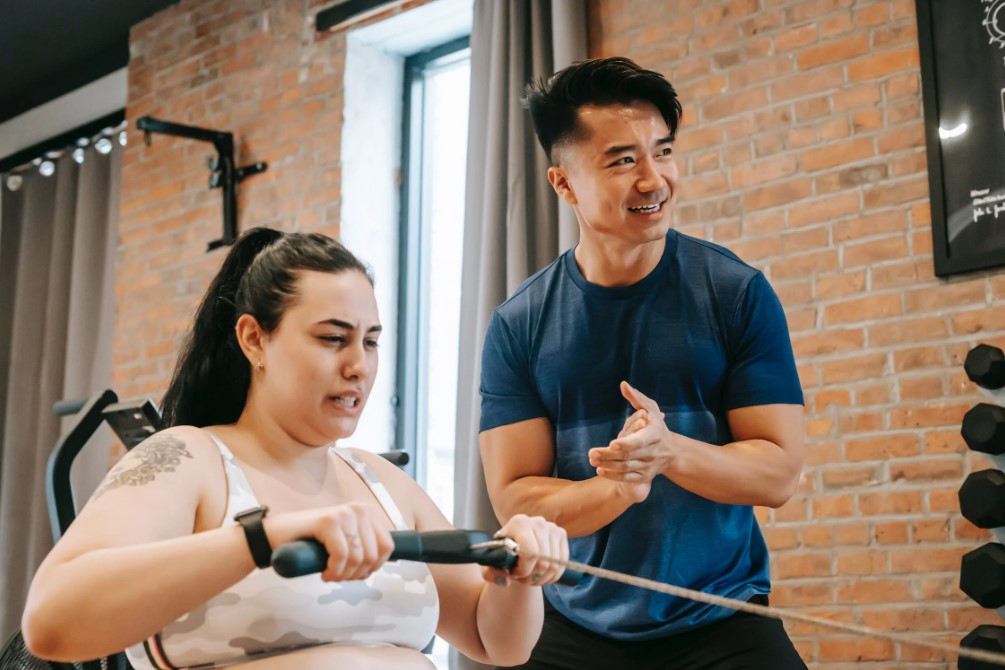In the contemporary world, where fitness is a priority, a personal gym trainer’s website serves as the digital storefront, making the first impression on potential clients. Crafting an engaging and functional website is pivotal for attracting fitness enthusiasts and showcasing the trainer’s expertise. This article unfolds a comprehensive guide on designing a personal gym trainer website that not only captivates visitors but also drives them towards their fitness goals.

Understanding Your Audience
Prior to embarking on the design journey, it is imperative to grasp the intricacies of the intended audience. Are you catering to beginners, athletes, or individuals with specific fitness goals? Tailoring the website to meet the needs of your audience ensures a more effective and personalized user experience.
Key Elements of an Impactful Personal Gym Trainer Website
1. Clear Branding and Mission Statement
• Develop a compelling mission statement that reflects your training philosophy and commitment to clients.
• Use consistent branding elements such as logos, colors, and taglines for a cohesive and professional look.
2. User-Friendly Navigation
• Establish a user-friendly menu layout that ensures seamless navigation for enhanced accessibility. Include sections for services, about the trainer,
testimonials, and contact information.
• Implement a booking system for scheduling sessions directly through the website.
3. Powerful Homepage
• Feature high-quality images and videos that showcase your training style and the gym environment.
• Craft a concise introduction that highlights your expertise and what sets your training apart.
4. Service Offerings and Packages
• Clearly outline the training services you offer, including personal training, group classes, and specialized programs.
• Provide detailed information on pricing, packages, and any ongoing promotions.
5. Client Testimonials and Success Stories
• Showcase client testimonials with before-and-after photos, illustrating real success stories.
• Use compelling narratives to highlight the positive impact of your training on clients’ lives.
6. Responsive Design
• Guarantee that the website is fine-tuned for optimal performance on mobile devices. A responsive design enhances the user experience across various devices.
• Consider the prevalence of mobile browsing and make navigation seamless on smartphones and tablets.
7. Call-to-Action (CTA) Buttons
• Place strategically located CTA buttons for actions like scheduling a consultation, signing up for a trial session, or joining a class.
• Employ compelling language to prompt instant involvement and interaction.
8. Interactive Elements
• Incorporate interactive elements like workout videos, live Q&A sessions, or virtual gym tours.
• Engaging features keep visitors on your site longer and foster a connection with your training approach.
9. Blog or Fitness Resources Section
• Share informative blog posts, workout routines, and nutritional tips.
• Regular updates not only educate visitors but also contribute to improved SEO.
10. Contact Information and Social Media Integration
• Clearly display contact details, including an inquiry form for potential clients.
• Integrate social media buttons to encourage visitors to connect on various platforms and stay updated.

Visual Aesthetics and Brand Identity
1. Color Scheme and Imagery
• Choose a color palette that reflects energy, motivation, and wellness.
• Use high-quality, diverse images that portray the gym atmosphere and the trainer’s active lifestyle.
2. Typography
• Opt for clear and readable fonts. Ensure that the text is legible across different screen sizes.
• Choose a font style that aligns with the energetic and professional image of your gym.
SEO Optimization
1. Keyword Optimization
• Incorporate relevant keywords related to personal training, gym services, and location for improved search engine visibility.
• Craft meta tags and descriptions with SEO in mind.
2. Local SEO Strategies
• Emphasize your gym’s local presence by including location-based keywords.
• Claim and optimize your Google My Business listing for improved local search results.

FAQs
Q1. How can I use my personal gym trainer website to attract new clients?
A: Utilize your homepage to showcase high-quality images and videos that highlight your training style and the unique atmosphere of your gym. Clearly outline your services, pricing, and encourage immediate engagement through strategically placed call-to-action buttons.
Q2. What role do client testimonials play in building trust on a personal gym trainer’s website?
A: Client testimonials serve as powerful social proof, showcasing real success stories and building trust among potential clients. Consider including before-and-after photos and personal narratives for a more impactful testimonial section.
Q3. Is it important to have a blog or resources section on my personal gym trainer website?
A: Yes, a blog or resources section not only positions you as an authority in the fitness industry but also contributes to improved SEO. Regularly share informative content, workout routines, and nutritional tips to engage and educate your audience.
Q4. How can I make my personal gym trainer website stand out visually?
A: Choose a vibrant color scheme that reflects energy and wellness. Use high-quality, diverse images that showcase your gym’s atmosphere and your active lifestyle. Ensure a clean and professional layout with readable fonts for a visually appealing website.
Q5. Should I integrate interactive elements on my personal gym trainer website?
A: Yes, incorporating interactive elements like workout videos, live Q&A sessions, or virtual gym tours adds a dynamic and engaging aspect to your website. This keeps visitors interested and connected with your training approach, fostering a positive user experience.
Q6. How can I effectively showcase my training expertise on my website?
A: Utilize the homepage to feature high-quality images of yourself in action, accompanied by a concise introduction highlighting your unique training approach and qualifications.
Q7. What role do client testimonials play in building trust on a personal trainer’s website?
A: Client testimonials serve as powerful social proof, showcasing real success stories and building trust among potential clients. Ensure to include before-and-after photos with client consent.
Q8. Why is mobile optimization crucial for a personal trainer’s website?
A: With the prevalence of mobile browsing, optimizing your website for mobile devices ensures a seamless and user-friendly experience for visitors, contributing to higher engagement.
Q9. How often should I update the content on my website’s blog section?
A: Regularly updating the blog section with valuable fitness tips, nutrition advice, and workout routines not only keeps visitors engaged but also contributes to improved SEO by showcasing fresh and relevant content.
Q10. Is it necessary to integrate interactive elements on a personal trainer’s website?
A: Yes, incorporating interactive elements like workout videos, live chat support, or virtual training sessions adds a dynamic and engaging aspect to your website, keeping visitors interested and involved.
Conclusion
Designing a personal gym trainer website goes beyond aesthetics; it’s about creating an immersive experience that resonates with fitness enthusiasts. By understanding your audience, incorporating key design elements, and optimizing for SEO, your website becomes a powerful tool for attracting and retaining clients on their fitness journey.




